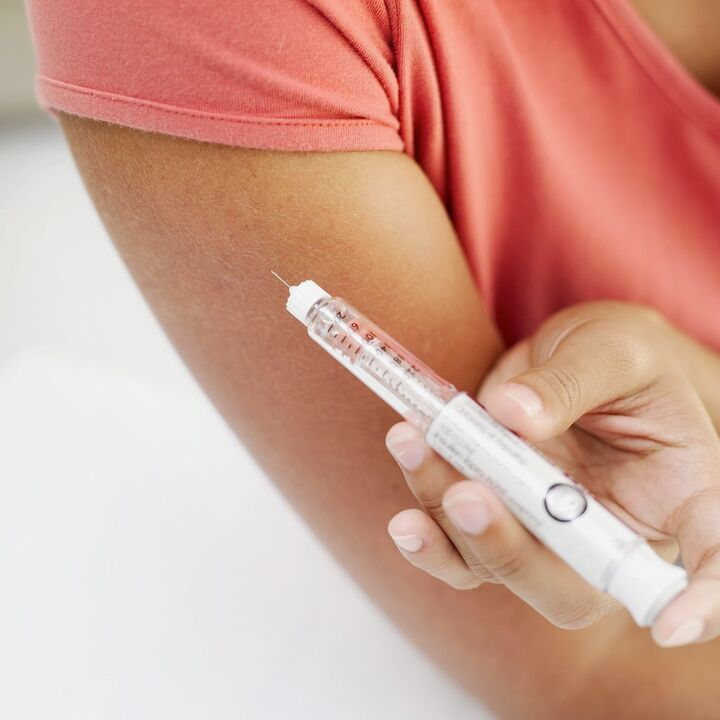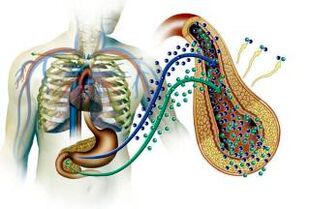Diabetes mellitus is a serious ailment, which is characterized by insulin deficiency to one degree or another. As a result of pathology, hyperglycemia may appear, that is, an increase in blood sugar, which will lead to various metabolic disorders and complications.
Diabetes is in third place in prevalence after cancer and cardiovascular diseases. Throughout the world, more than one hundred million people with this disease are currently known. Every 15 years, the number of cases doubles.
Drugs that can completely eliminate the manifestations of diabetes does not exist. If the disease is not treated for a long time, then irreversible disorders in the vessels of various organs occur.
To notice the symptoms of pathology in time, you should know what types of diabetes exist.
Types of diabetes

In medicine, several types of diabetes are released. The term itself reveals a whole list of diseases with common features. Features of diabetes and their types consists in the pathological level of blood sugar.
There are a lot of reasons why insulin cannot cause glucose to cells from the blood. Nevertheless, the result is always the same: with strong saturation of blood with sugar, cells cannot eat normally.
When sugar does not fall into the cells, it pulls the water over himself. A liquid filling the bloodstream goes through the kidneys, and dehydration occurs. Despite what diabetes there are, there are such symptoms:
- Dry mouth.
- Thirst.
- Frequent and abundant urination.
Each type of ailment is distinguished by its own characteristic effect on the human body. Diabetes, the types of which have their own differences, maybe:
- Nonachary and sugar.
- Latent.
- Potential, it is expressed in predisposition to the disease.
- Insulin -dependent and insulin -dependent.
- Laby.
- Renal.
- Postoperative, it appears after surgery on the pancreas.
- Pancreatic, expressed in the lesion of the pancreas.
- Non -Pancretical, it is not associated with damage to the pancreas.
The first type of diabetes mellitus

Insulin -dependent diabetes is called autoimmune or viral damage to the pancreas, the organ producing insulin. People with type 1 diabetes, insulin either does not have no at all, or it is in very small volumes.
Statistics suggest that type 1 disease appears at a young age. It is determined by such symptoms as frequent severe thirst, rapid urination, quick weight loss, strong feeling of hunger and the appearance of acetone in the urine.
Treatment of this variety of the disease is to introduce the desired dose of the hormone from the outside. Other therapeutic actions are completely ineffective. The first type of diabetes appears most often due to genetic predisposition. Such a disease can provoke one or more negative factors, starting pathological changes in the immune system.
As a result, pancreatic cells are deformed, producing insulin. The lack of hormone leads to the fact that carbohydrates cannot be completely disposed of in the body, and the lack of energy is trying to make up for fat processing.
Toxic substances begin to enter the brain. Therefore, it is extremely important to constantly control the current state of the body and the content of glucose in the blood.
The disease may occur due to:
- Infections.
- Stress.
- Sedentary lifestyle.
- Autoimmune diseases.
- Heredity.
- Inal meals.
Such diabetes is up to 15% of the total number of patients. Most often, children and adolescents get sick. The ailment appears due to a passive lifestyle, and constant use of carbohydrates. Obesity and diabetes can appear when taking:
- Soda drinks.
- Smoked meats.
- Canned products.
- Fast-food.
Sometimes diabetes, and then obesity first appears. Type 1 disease has such symptoms:
- Weakness.
- Irritability.
- A feeling of fatigue.
- Nausea.
- Enhanced thirst.
- Calls to urination.
Often patients rapidly lose weight of the body, or vice versa gain weight. Diabetes can be:
- Primary: genetic, essential.
- Secondary: thyroid, pituitary, steroid.
The disease can be mild, medium or serious. By the nature of the course, the disease is divided into insulin -dependent and insulin -dependent type. Due to the high content of sugar in the blood, the buds and blood vessels are deformed.
Therefore, people suffering from an ailment of type 1, in many cases, lose their eyesight, becoming almost blind. There are also two main manifestations: first a violation of the kidneys, then - the failure of this organ. Often patients note pain and numbness of the limbs. This is due to a violation of blood circulation and damage to the nerves.
In case of violation of blood flow in the feet, there is a high risk of amputation of the legs. With type 1 disease, there is a high volume of cholesterol in the blood, therefore, in diabetics, cases of stroke or myocardial infarction are not uncommon.
In men with diabetes, impotence often develops, since nerve and blood vessels cease to exist in a healthy regime. Due to the pathology, they appear:
- Obesity.
- Pancreatitis.
- Dermatopathy.
- Nephropathy.
- Encephalopathy.
One of the pathologies that pose a great danger is the hypoglycemic coma. This condition often leads to death.
Patients with diabetes should determine the blood sugar level every day using special devices created for home conditions. If necessary, urine is prescribed for sugar content.
If the glucose level is increased, then insulin injections are required to treat the ailment of 1 type. This hormone is involved in the metabolism, allowing the body to process carbohydrates.
If there is no adequate treatment of type 1 diabetes, then serious complications appear. In some cases, death is possible. Sometimes a person needs hospitalization to establish the complexity of the situation.
In stationary conditions, the patient is taught new sugar control skills.
The second type of diabetes mellitus

This type of disease occurs with insufficient insulin products by the pancreas. The condition is also aggravated by a decrease in cell activity of this organ. Typically, pathology is formed due to the hereditary non -consumption of tissues to the hormone.
The fabrics that are subjected to insulin have insulin receptors. Due to the appearance of the pathology of these receptors, the immunity of tissues to insulin develops. The secretion of the hormone does not decrease, forming the relative insulin deficiency.
In patients with obesity, first of all, there is a decrease in the function of insulin receptors. Overflow leads to an excess formation of glucose in the blood, while non -controversial tissues do not make it possible to get glucose into the cells.
Since a sufficient amount of insulin is needed to get sugar into the cells, its excessive products of the pancreas begins, which is wrapped in exhaustion of beta cells.
2 of the type of diabetes in medicine is not considered hereditary pathology, but a disease of the wrong lifestyle. Even with existing severe heredity, such a violation will not be formed if:
- The use of sweet products and other "fast" carbohydrates is limited.
- No overeating.
- There is constant control over body mass.
- Physical exercises are constantly performed.
Type 2 diabetes symptoms are not specific. The person does not notice their manifestations, in most cases, since there is no significant deterioration in well -being. But knowing the symptoms, you can not miss the moment of their appearance and consult a doctor in time, determining the concentration of glucose in the blood. Therefore, successful compensation for diabetes will be created, the risk of complications will significantly decrease.
The main manifestations of this pathology:
- Dry mouth.
- An increase in the volume of urine, which makes a person constantly wake up at night.
- Strong thirst.
- Itching of the mucous membranes.
- Strong appetite associated with the failure of leptin synthesis.
The presence of diabetes can also talk:
- Slow restoration of wounds.
- Furunculosis.
- Impotence.
- Fungal infections.
The ailment can be found for the first time when entering the hospital due to a stroke or heart attack. Such diseases indicate that diabetes is in a serious stage.
The usual symptoms are manifested only with an increase in sugar level above the renal threshold - 10 mmol /l. With this increase in glucose, it appears in the urine. If the value does not reach 10 mmmol/l of blood, then, a person does not feel changes in the body.
It can be noted that the random installation of type 2 diabetes is a very common phenomenon.
For diabetes therapy, 2 types are used: the following means are used:
- Biguanides.
- Thiosolidindo.
- Cost sulfanillarochevina.
- Clay.
Gestational diabetes
The gestational form of the disease can appear in a pregnant woman. The pathology is formed due to insufficient production of insulin, which is needed to regulate blood sugar.
During pregnancy, the woman’s body is forced to produce a large amount of insulin, which provides the needs of the fetus. This process is especially relevant in the second half of the childish.
If there is a lack of insulin, then the level of glucose in the blood is constantly increasing, giving the opportunity to form a gestational type of diabetes. This disease usually takes place independently, immediately after childbirth.
This is a characteristic feature that distinguishes it from other types of diabetes, which are chronic.
Latent diabetes

A large number of unclear moments are associated with diabetes. The most common types of ailment are the first and second types. It is worth noting that there is an intermediate type of this dangerous disease called Lada Diabetes.
Such a disease occurs in adulthood. This variety of the disease is dangerous in that for a long time it can be disguised as type 2 diabetes. The latent form of the disease is very difficult.
Lada is a serious autoimmune disease. The immune system begins to attack its own organism, constantly destroying beta cells that produce insulin in the pancreas. But such patients can do without insulin injections for a long time, unlike those who are more type 1 diabetes.
With a latent form of diabetes, immune processes proceed quite slowly. At the pancreas, working beta cells are preserved. Patients show treatment with drugs that are intended for diabetics with the 2nd type of diabetes. Over time, antibodies destroy more and more beta cells, which leads to a serious decrease in the amount of insulin and the inevitable use of insulin therapy.
Hidden diabetes
Hidden diabetes mellitus has another name: latent or sleeping. This pathology is a diabetes at an early stage.
With a preliminary stage of diabetes, sugar and its blood indicators never exceeds the norm. At the initial stage of the disease, a violation of glucose tolerance is recorded. Further, after sugar load, a person is noted in the blood very slow, but a decrease in glucose concentration.
Such people have a rather high probability of diabetes in 10-15 years. This ailment does not require specific complex therapy, but constant medical observation is important. The latent type of diabetes mellitus can occur over the years.
To develop it, it is sometimes enough to survive a serious nervous disorder or to get a viral infection.
Non -adalar diabetes
Non -adalar diabetes is a pathology, which is caused by the absolute or relative deficiency of vasopressin, a hormone, which has an antidiuretic effect. People suffer from sudden urination and thirst. Sleep is significantly broken, and a person cannot normally restore strength.
About 6-15 liters of loose, light urine are released per day. There is also a lack of appetite and weight loss. A person is constantly tired and irritated, dry skin and lack of sweating are observed.
Subcompensated diabetes
Diabetes mellitus is a disease that consists in impaired carbohydrate metabolism. All medical measures are aimed at normalizing it. It is quite difficult to achieve a steady effect. Due to prolonged therapy, the level of carbohydrate metabolism can fluctuate and have different values.
There are several forms that allow you to compensate for this dangerous disease. We are talking about:
- Decompensated.
- Subcompensated.
- Compensated form.
The decompensated form is characterized by the fact that there is almost no improvement in carbohydrate metabolism. There is a high concentration of glucose in the blood, acetone and sugar are found in the urine.
Subcompensated diabetes is a pathology in which blood sugar does not differ much from the norm, there is also no acetone in the urine. With the compensated form of the disease, a person has glucose in normal, while there is no sugar in the urine.
Laby diabetes
The disease can be differentiated by the nature of the course to labile and stable. The labile type of ailment is characterized by a significant fluctuation of glucose in the blood daily.
In such people, hypoglycemia appears, most often by dinner. Late at night and early in the morning there is a strong thirst and hyperglymp. The hidden course of the disease is often accompanied by the formation of ketoacidosis, which often leads to a diabetic coma.
A quick replacement of hypoglycemia hyperglycemia is characteristic of youth and childish diabetes. The stability of the course of the disease is characteristic of its average stage. The disease proceeds labilly when it is severe.























